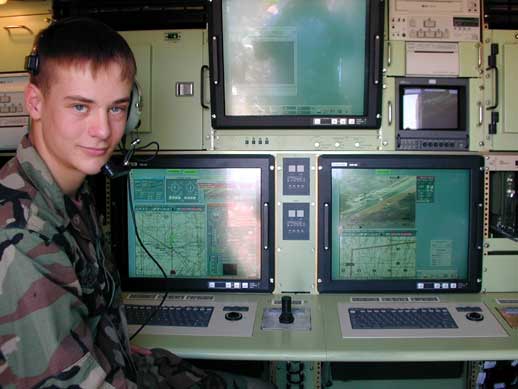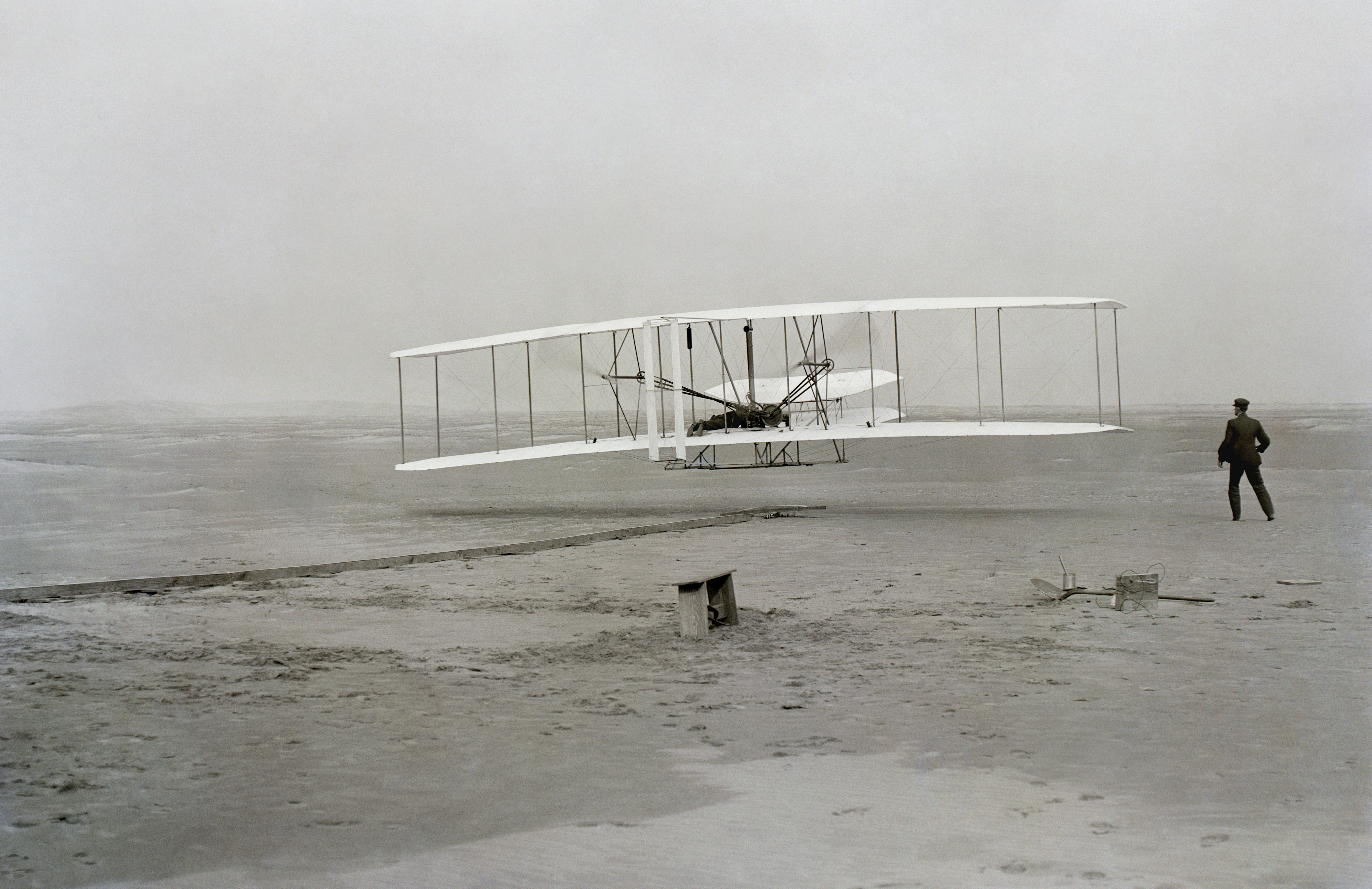|
RQ-7
The AAI RQ-7 Shadow is an American unmanned aerial vehicle (UAV) used by the United States Army, Australian Army, Swedish Army, Turkish Air Force and Italian Army for reconnaissance, surveillance, target acquisition and battle damage assessment. Launched from a trailer-mounted pneumatic catapult, it is recovered with the aid of arresting gear similar to jets on an aircraft carrier. Its gimbal-mounted, digitally stabilized, liquid nitrogen-cooled electro-optical/infrared (EO/IR) camera relays video in real time via a C-band line-of-sight data link to the ground control station (GCS). The US Army's 2nd Battalion, 13th Aviation Regiment at Fort Huachuca, Arizona, trains soldiers, Marines, and civilians in the operation and maintenance of the Shadow UAS. The Shadow is operated in the U.S. Army at brigade-level. Development The RQ-7 Shadow is the result of a continued US Army search for an effective battlefield UAS after the cancellation of the Alliant RQ-6 Outrider aircraft. AAI ... [...More Info...] [...Related Items...] OR: [Wikipedia] [Google] [Baidu] |
AAI Corporation
AAI Corporation is an aerospace and defense development and manufacturing firm, located in Hunt Valley, Maryland, US. Formerly a wholly owned subsidiary of United Industrial Corporation, AAI was acquired by Textron in 2007. It currently operates as a unit of Textron Systems and employs more than 2,000. AAI's products and services include unmanned aircraft and ground control technologies; training and simulation systems; automated aerospace test and maintenance equipment; armament systems; and logistical, engineering, supply chain and operational support services, multi-turreted tracked ground combat vehicles. The company's customers include the United States Department of Defense (DoD) and its prime contractors, allied foreign government ministries of defense, and other United States federal agencies. History AAI Corporation originated as Aircraft Armaments, Inc. in August 1950, founded by six aviation and defense industry professionals. It was renamed AAI Corporation in ... [...More Info...] [...Related Items...] OR: [Wikipedia] [Google] [Baidu] |
2nd Battalion, 13th Aviation (United States)
The 13th Aviation Regiment is a regiment of the United States Army. 1st Battalion, 13th Aviation The 1st Battalion, 13th Aviation Regiment manages new recruits who have recently graduated basic training and who have reported to Fort Rucker to receive their military occupational specialty identifier before reporting to their first duty station. The battalion orchestrates and implements the majority of enlisted training at Fort Rucker. The 6th Military Police Detachment and an element of the 46th Engineer Battalion is also assigned to 1-13th. Fort Rucker’s military and civilian firefighters are assigned under the 6th MP Detachment. 2nd Battalion, 13th Aviation The 2nd Battalion, 13th Aviation Regiment, which replaced the Unmanned Aircraft Systems Training Battalion (UASTB)(Provisional), is based at Fort Huachuca, Arizona. Its primary mission is to train soldiers in the operation and maintenance of the RQ-7B Shadow and MQ-1C Gray Eagle unmanned aircraft systems. 2–13th Avia ... [...More Info...] [...Related Items...] OR: [Wikipedia] [Google] [Baidu] |
AAI RQ-2 Pioneer
The AAI RQ-2 Pioneer is an unmanned aerial vehicle (UAV) that had been used by the United States Navy, Marine Corps, and Army, and deployed at sea and on land from 1986 until 2007. Initially tested aboard USS ''Iowa'', the RQ-2 Pioneer was placed aboard s to provide gunnery spotting, its mission evolving into reconnaissance and surveillance, primarily for amphibious forces. It was developed jointly by AAI Corporation and Israel Aircraft Industries. The program grew out of successful testing and field operation of the Tadiran Mastiff UAV by the American and Israeli militaries. Essentially, the Pioneer is an upgraded IAI Scout which was re-engined to accommodate a greater payload by request of the US Navy. To accomplish this, the original "Limbach" two-cylinder two-stroke engine was replaced with a Fichtel & Sachs two-cylinder two-stroke. The Limbach motor used a 71 cm propeller from Propeller Engineering and Duplicating, Inc. of San Clemente, California. The newer, more powe ... [...More Info...] [...Related Items...] OR: [Wikipedia] [Google] [Baidu] |
Australian Army
The Australian Army is the principal Army, land warfare force of Australia, a part of the Australian Defence Force (ADF) along with the Royal Australian Navy and the Royal Australian Air Force. The Army is commanded by the Chief of Army (Australia), Chief of Army (CA), who is subordinate to the Chief of the Defence Force (Australia), Chief of the Defence Force (CDF) who commands the ADF. The CA is also directly responsible to the Minister of Defence (Australia), Minister for Defence, with the Department of Defence (Australia), Department of Defence administering the ADF and the Army. Formed in 1901, as the Commonwealth Military Forces, through the amalgamation of the colonial forces of Australia following the Federation of Australia. Although Australian soldiers have been involved in a number of minor and major conflicts throughout Australia's history, only during the Second World War has Australian territory come under direct attack. The Australian Army was initially composed a ... [...More Info...] [...Related Items...] OR: [Wikipedia] [Google] [Baidu] |
UAV Ground Control Station
UAV ground control station (GCS) is a land- or sea-based control centre that provides the facilities for human control of ''Unmanned Aerial Vehicles'' (UAVs or "drones"). It may also refer to a system for controlling rockets within or above the atmosphere, but this is typically described as a Mission Control Centre. Hardware 300px, The inside of the Bayraktar TB2 GCS GCS hardware refers to the complete set of ground-based hardware systems used to control the UAV. This typically includes the Human-Machine Interface, computer, telemetry, video capture card and aerials for the control, video and data links to the UAV. Fixed Installation and Vehicle Mounted GCS 300px, Two ground control stations of Bayraktar_TB2.html" ;"title="Ukrainian Air Force Bayraktar TB2">Ukrainian Air Force Bayraktar TB2 Larger military UAVs such as the General Atomics MQ-1 Predator feature what resembles a "virtual cockpit". The pilot or Airborne Sensor Operator, sensor operator sits in front of ... [...More Info...] [...Related Items...] OR: [Wikipedia] [Google] [Baidu] |
Alliant RQ-6 Outrider
The Alliant RQ-6 Outrider unmanned aerial vehicle (UAV) was designed to provide near-real-time reconnaissance, surveillance, and target acquisition information to United States Marine Corps air/ground task forces, United States Army brigades, and deployed United States Navy units that was small enough for an entire system to be contained on two Humvees and trailer and transported on a single C-130 Hercules The Lockheed C-130 Hercules is an American four-engine turboprop military transport aircraft designed and built by Lockheed (now Lockheed Martin). Capable of using unprepared runways for takeoffs and landings, the C-130 was originally des ... cargo aircraft. The project began in 1996 and was cancelled in 1999. The "R" is the Department of Defense designation for reconnaissance; "Q" means unmanned aircraft system. The "6" refers to its being the sixth of a series of purpose-built unmanned aircraft systems. Specifications See also References External linksRQ-6 ... [...More Info...] [...Related Items...] OR: [Wikipedia] [Google] [Baidu] |
C Band (IEEE)
The C band is a designation by the Institute of Electrical and Electronics Engineers (IEEE) for a portion of the electromagnetic spectrum in the microwave range of frequencies ranging from 4.0 to 8.0 gigahertz (GHz). However, the U.S. Federal Communications Commission C band proceeding and auction, designated 3.7–4.2 GHz as C band. The C band is used for many satellite communications transmissions, some Wi-Fi devices, some cordless telephones, as well as some Radar and weather radar systems. Use in satellite communication The communications C band was the first frequency band that was allocated for commercial telecommunications via satellites. The same frequencies were already in use for terrestrial microwave radio relay chains. Nearly all C-band communication satellites use the band of frequencies from 3.7 to 4.2 GHz for their downlinks, and the band of frequencies from 5.925 to 6.425 GHz for their uplinks. Note that by using the band fr ... [...More Info...] [...Related Items...] OR: [Wikipedia] [Google] [Baidu] |
Empennage
The empennage ( or ), also known as the tail or tail assembly, is a structure at the rear of an aircraft that provides stability during flight, in a way similar to the feathers on an arrow.Crane, Dale: ''Dictionary of Aeronautical Terms, third edition'', p. 194. Aviation Supplies & Academics, 1997. Aviation Publishers Co. Limited, ''From the Ground Up'', p. 10 (27th revised edition) The term derives from the French language verb ''empenner'' which means " to feather an arrow". Most aircraft feature an empennage incorporating vertical and horizontal stabilising surfaces which stabilise the flight dynamics of yaw and pitch, as well as housing control surfaces. In spite of effective control surfaces, many early aircraft that lacked a stabilising empennage were virtually unflyable. Even so-called " tailless aircraft" usually have a tail fin (usually a vertical stabiliser). Heavier-than-air aircraft without any kind of empennage (such as the Northrop B-2) are rare, and generally ... [...More Info...] [...Related Items...] OR: [Wikipedia] [Google] [Baidu] |
Pusher Configuration
In an aircraft with a pusher configuration (as opposed to a tractor configuration), the propeller(s) are mounted behind their respective engine(s). Since a pusher propeller is mounted behind the engine, the drive shaft is in compression in normal operation. Pusher configuration describes this specific (propeller or ducted fan) thrust device attached to a craft, either aerostat (airship) or aerodyne (aircraft, WIG, paramotor, rotorcraft) or others types such as hovercraft, airboat and propeller-driven snowmobiles. "Pusher configuration" also describes the layout of a fixed-wing aircraft in which the thrust device has a pusher configuration. This kind of aircraft is commonly called a pusher. Pushers have been designed and built in many different layouts, some of them quite radical. History The rubber-powered "Planophore", designed by Alphonse Pénaud in 1871, was an early successful model aircraft with a pusher propeller. Many early aircraft (especially biplane ... [...More Info...] [...Related Items...] OR: [Wikipedia] [Google] [Baidu] |
Wing Configuration
The wing configuration of a fixed-wing aircraft (including both gliders and powered aeroplanes) is its arrangement of lifting and related surfaces. Aircraft designs are often classified by their wing configuration. For example, the Supermarine Spitfire is a conventional low wing cantilever monoplane of straight elliptical planform with moderate aspect ratio and slight dihedral. Many variations have been tried. Sometimes the distinction between them is blurred, for example the wings of many modern combat aircraft may be described either as cropped compound deltas with (forwards or backwards) swept trailing edge, or as sharply tapered swept wings with large leading edge root extensions (or LERX). Some are therefore duplicated here under more than one heading. This is particularly so for variable geometry and combined (closed) wing types. Most of the configurations described here have flown (if only very briefly) on full-size aircraft. A few theoretical designs are also notab ... [...More Info...] [...Related Items...] OR: [Wikipedia] [Google] [Baidu] |
Preflight Inspections RQ-7B Shadow
{{disambiguation ...
Pre-flight or Preflight may refer to: * Walk-around, the pre-flight inspection of an aircraft by its pilot or flight engineer * Pre-flight (printing), by analogy with the above * ''Preflight'' (EP), a 2002 EP by Building 429 * Preflight request, a request made by modern web browsers to perform certain cross-origin resource sharing Cross-origin resource sharing (CORS) is a mechanism that allows restricted resources on a web page to be requested from another domain outside the domain from which the first resource was served. A web page may freely embed cross-origin images, ... [...More Info...] [...Related Items...] OR: [Wikipedia] [Google] [Baidu] |







